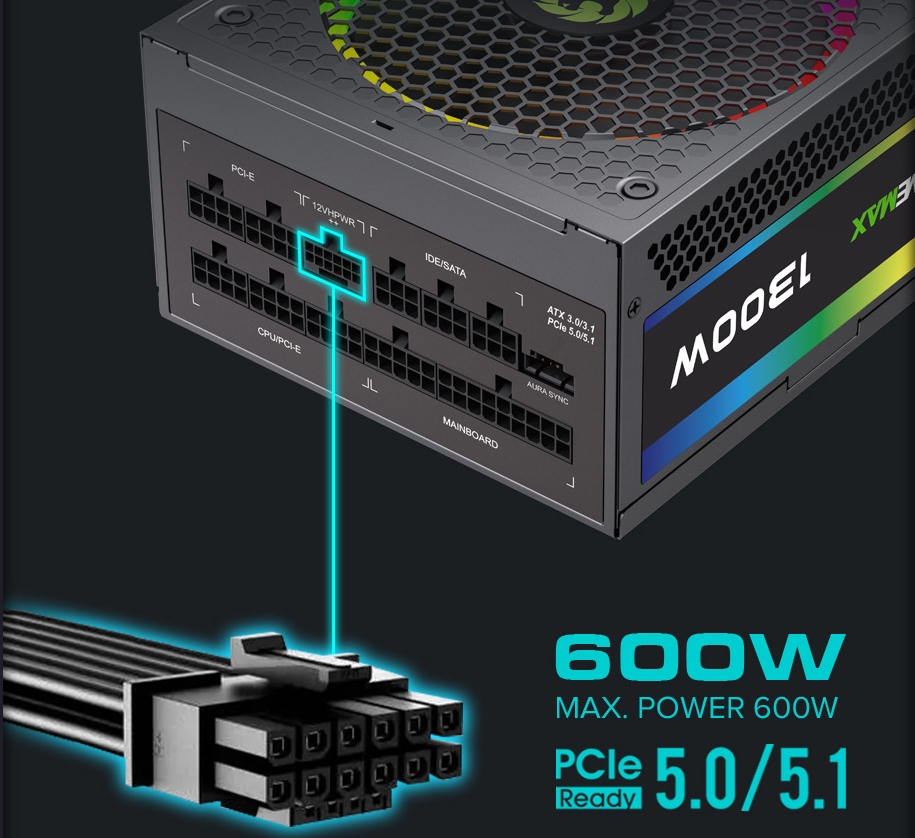In the ever-evolving world of PC hardware, keeping up with the latest standards for power supplies and components is crucial for ensuring optimal performance and future-proofing your system. Two important standards to be aware of are PCIe (Peripheral Component Interconnect Express) and ATX (Advanced Technology eXtended), both of which have seen updates in recent years. This article will explore the differences between PCIe 5.1 and 5.0, ATX 3.1 and 3.0, and provide guidance on how to determine if a power supply supports these latest standards. Additionally, we'll recommend a GameMax 850W power supply that meets these criteria.
PCIe (Peripheral Component Interconnect Express) is a high-speed interface used to connect various hardware components such as graphics cards, SSDs, and other expansion cards to the motherboard. As technology progresses, PCIe standards evolve to provide improved performance and capabilities.

Released: 2020
Bandwidth: 32 GT/s (Giga-transfers per second) per lane
Features: PCIe 5.0 doubled the bandwidth of PCIe 4.0, offering a total of 64 GB/s (gigabytes per second) in a x16 configuration. This increased bandwidth is beneficial for high-performance tasks such as gaming, data transfer, and professional workloads.
Compatibility: PCIe 5.0 is backward-compatible with PCIe 4.0 and 3.0 devices.
Released: 2022
Bandwidth: Same as PCIe 5.0, 32 GT/s per lane
Features: PCIe 5.1 introduces enhancements to the existing protocol, including support for more advanced features like improved power efficiency and increased signal integrity. One of the key improvements is the introduction of a new feature called "Built-in ECC" (Error Correction Code) for enhanced reliability.
Compatibility: PCIe 5.1 maintains backward compatibility with PCIe 5.0 and earlier versions.

The ATX standard defines the physical dimensions, mounting points, and power connections for PC power supplies and motherboards. The updates in these standards typically involve improvements in efficiency, connectivity, and power delivery.
Released: 2021
Features: ATX 3.0 introduced support for the latest PCIe 5.0 standard and improved power efficiency. It also included enhancements for better power management and thermal performance, ensuring that power supplies can handle the higher demands of modern components.
Compatibility: ATX 3.0 power supplies are designed to be compatible with older ATX standards, including ATX 2.2 and ATX 2.4.
Released: Expected 2024
Features: ATX 3.1 is set to further refine power delivery and efficiency. While specific details may vary, ATX 3.1 is expected to provide even better support for high-performance components and improved energy efficiency, making it suitable for the latest GPUs and CPUs.
Compatibility: ATX 3.1 will continue to support older ATX standards while offering enhancements that improve overall system stability and performance.
To determine if a power supply supports the latest PCIe and ATX standards, follow these steps:
Check the Specifications: Review the product specifications provided by the manufacturer. Look for details on PCIe version and ATX standard compatibility. This information is often listed on the product page or in the technical specifications section.
Look for Certification Labels: Some power supplies come with certification labels or logos indicating support for specific standards. For example, a PSU labeled with "PCIe 5.1" or "ATX 3.1" means it adheres to those standards.
Consult the Manufacturer: If the specifications are unclear, contact the manufacturer directly for confirmation. They can provide detailed information on whether their power supply supports PCIe 5.1 and ATX 3.1.
Examine the Power Connectors: Modern power supplies that support PCIe 5.1 will often have updated PCIe power connectors to handle the higher power requirements of the latest GPUs. Similarly, ATX 3.1 compliant PSUs will feature connectors and power delivery systems that meet the new standards.
For those seeking a high-quality power supply that supports both PCIe 5.1 and ATX 3.1 standards, the GameMax 850W power supply is an excellent choice. Here’s why:
Power Rating: With an 850W capacity, this PSU offers ample power for high-performance components, ensuring stable operation even under heavy loads.
PCIe 5.1 Support: The GameMax 850W PSU is designed to meet the latest PCIe 5.1 standards, providing enhanced performance and reliability for modern GPUs.
ATX 3.1 Compatibility: It complies with ATX 3.1 standards, ensuring compatibility with the latest motherboards and offering improved power efficiency.
Cable Management: The PSU features fully modular cables, which helps in maintaining a clean and organized build, enhancing both aesthetics and airflow.
Choosing the right power supply for your PC build involves understanding the differences between various standards such as PCIe 5.1 vs 5.0 and ATX 3.1 vs 3.0. By selecting a PSU that supports these latest standards, you ensure that your system is future-proofed and capable of handling the most demanding components. The GameMax 850W power supply is a recommended option that meets these requirements, offering reliable power delivery and enhanced performance for modern builds.